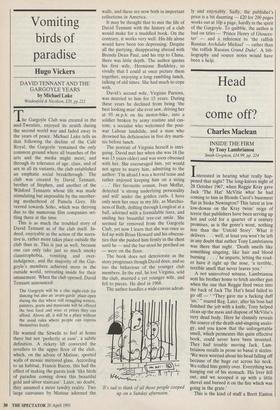Vomiting birds of paradise
Hugo Vickers
DAVID TENNANT AND THE GARGOYLE YEARS by Michael Luke
Weidenfeld & Nicolson, £20, pp.212
The Gargoyle Club was created in the mid-Twenties, enjoyed its zenith during the second world war and faded away in the years of peace. Michael Luke tells us that following the decline of the Café Royal, the Gargoyle 'remained the only common ground where all branches of the arts and the media might meet; and through its tolerance of age, class, and of sex in all its variants, the club established an emphatic social breakthrough.' The club was created by David Tennant, brother of Stephen, and another of the Wilsford Tennants whose life was made stimulating but impossible by the smother- ing motherhood of Pamela Grey. He veered towards Soho, which was thriving due to the numerous film companies set- tling there at the time.
This is as much the troubled story of David Tennant as of the club itself. In- deed, enjoyable as the action of the narra- tive is, rather more takes place outside the club than in. This is just as well, because one can only take just so much smoky claustrophobia, vomiting and over- indulgence, and the majority of the Gar, goyle's members achieved more in the outside world, retreating inside for their amusement. When the club opened, David Tennant announced:
The Gargoyle will be a chic night-club for dancing but also an 'avant-garde' place open during the day where still struggling writers, painters, poets and musicians will be offered the best food and wine at prices they can afford. Above all, it will be a place without the usual rules where people can express themselves freely.
He wanted the Sitwells to feel at home there but not 'perfectly at ease', a subtle definition. A rickety lift conveyed the revellers to the upper floor of the club, which, on the advice of Matisse, sported walls of mosaic mirrored glass. According to an habitué, Francis Bacon, this had the effect of making the guests look 'like birds of paradise coming down this beautiful gold and silver staircase'. Later, no doubt, they assumed a more tawdry reality. Two large canvasses by Matisse adorned the walls, and these are now both in important collections in America.
It may be thought that to mix the life of David Tennant with the history of a club would make for a muddled book. On the contrary, it works very well. His life alone would have been too depressing. Despite all the partying, disappearing abroad with Brenda Dean Paul, and his trip to China, there was little depth. The author quotes his first wife, Hermione Baddeley, so vividly that I could at once picture them together, enjoying a long rambling lunch, talking of old times. She had much to cope with.
David's second wife, Virginia Parsons, was married to him for 15 years. During these years he declined from being 'the best looking man' she ever saw, driving her at 95 m.p.h on his motor-bike, into a soldier broken by army routine and cus- tom, a socialist who welcomed the post- war Labour landslide, and a man who drowned his deficiencies in five dry marti- nis before lunch.
The portrait of Virginia herself is intri- guing. David met her when she was 18 (he was 15 years older) and was soon obsessed with her. She encouraged him, yet would not agree to marry him, admitting to the author: 'I'm afraid I was a horrid tease and rather enjoyed keeping him on a string . . .' Her favourite cousin, Ivan Moffat, detected 'a strong underlying personality and will' under the golden curls. I have only seen her once in my life, as Marchio- ness of Bath, drifting through Longleat at a ball, adorned with a formidable tiara, and smiling her beautiful tree-cat smile. She seemed far removed from the Gargoyle Club, yet now I learn that she was once so fed up with Brian Howard and his obsceni- ties that she pushed him firmly in the chest until he — and the bar-stool he perched on — were on the floor.
The book does not deteriorate as the story progresses though David does, and so too the behaviour of the younger club members. In the end, he lost Virginia, sold the club, married a yet younger wife, and fell to pieces. He died in 1968. The author handles a wide canvas adroit-
'It's sad to think of all those people cooped up on a Sunday afternoon.'
ly and enjoyably. Sadly, the publisher's price is a bit daunting — £20 for 200 pages works out at 10p a page, hardly in the spirit of the Gargoyle. To quibble, the author is bad on titles — 'Prince Henry of Glouces- ter' — and a reference to 'the raffish Russian Archduke Michael' — rather than 'the raffish Russian Grand Duke'. A bib- liography and source notes would have been a help.


























































 Previous page
Previous page